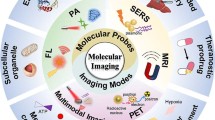Abstract
The purpose of writing this review is to showcase the Molecular Imaging and Contrast Agent Database (MICAD; www.micad.nlm.nih.gov) to students, researchers, and clinical investigators interested in the different aspects of molecular imaging. This database provides freely accessible, current, online scientific information regarding molecular imaging (MI) probes and contrast agents (CA) used for positron emission tomography, single-photon emission computed tomography, magnetic resonance imaging, X-ray/computed tomography, optical imaging and ultrasound imaging. Detailed information on >1,000 agents in MICAD is provided in a chapter format and can be accessed through PubMed. Lists containing >4,250 unique MI probes and CAs published in peer-reviewed journals and agents approved by the United States Food and Drug Administration as well as a comma separated values file summarizing all chapters in the database can be downloaded from the MICAD homepage. Users can search for agents in MICAD on the basis of imaging modality, source of signal/contrast, agent or target category, pre-clinical or clinical studies, and text words. Chapters in MICAD describe the chemical characteristics (structures linked to PubChem), the in vitro and in vivo activities, and other relevant information regarding an imaging agent. All references in the chapters have links to PubMed. A Supplemental Information Section in each chapter is available to share unpublished information regarding an agent. A Guest Author Program is available to facilitate rapid expansion of the database. Members of the imaging community registered with MICAD periodically receive an e-mail announcement (eAnnouncement) that lists new chapters uploaded to the database. Users of MICAD are encouraged to provide feedback, comments, or suggestions for further improvement of the database by writing to the editors at micad@nlm.nih.gov.



Similar content being viewed by others
References
Cheng KT, Menkens A, Bryant S et al (2007) NIH MICAD initiative and guest author program opportunities. J Nucl Med 48:19N
Chopra A, Shan L, Eckelman EC, et al. (2011) Important parameters to consider for the characterization of PET and SPECT imaging probes. Nucl Med Biol [Epub ahead of print].
Willmann JK, van Bruggen N, Dinkelborg LM et al (2008) Molecular imaging in drug development. Nat Rev Drug Discov 7:591–607
Massoud TF, Gambhir SS (2003) Molecular imaging in living subjects: seeing fundamental biological processes in a new light. Genes Dev 17:545–580
Piwnica-Worms DR (2004) Introduction to molecular imaging. J Am Coll Radiol 1:2–3
Amidon GL (2004) Molecular pharmaceutics: the NIH Roadmap and the FDA pipeline problem. Mol Pharm 1:337
Check E (2003) NIH ‘roadmap’ charts course to tackle big research issues. Nature 425:438
Shi ZD, Wu H, Ruddy B et al (2007) Imaging Probe Development Center: a National Institutes of Health core synthesis resource for imaging probes. J Biomed Opt 12:051502
Sayers EW, Barrett T, Benson DA et al (2011) Database resources of the National Center for Biotechnology Information. Nucleic Acids Res 39:D38–D51
Haight AE, Kaste SC, Goloubeva OG et al (2003) Nephrotoxicity of iopamidol in pediatric, adolescent, and young adult patients who have undergone allogeneic bone marrow transplantation. Radiology 226:399–404
Weichert JP, Lee FT Jr, Longino MA et al (1998) Lipid-based blood-pool CT imaging of the liver. Acad Radiol 5(Suppl 1):S16–S19, discussion S28-30
Ford NL, Graham KC, Groom AC et al (2006) Time-course characterization of the computed tomography contrast enhancement of an iodinated blood-pool contrast agent in mice using a volumetric flat-panel equipped computed tomography scanner. Invest Radiol 41:384–390
Cheong BY, Muthupillai R (2010) Nephrogenic systemic fibrosis: a concise review for cardiologists. Tex Heart Inst J 37:508–515
Cho EC, Glaus C, Chen J et al (2010) Inorganic nanoparticle-based contrast agents for molecular imaging. Trends Mol Med 16:561–573
Godin B, Driessen WH, Proneth B et al (2010) An integrated approach for the rational design of nanovectors for biomedical imaging and therapy. Adv Genet 69:31–64
Louie A (2010) Multimodality imaging probes: design and challenges. Chem Rev 110:3146–3195
Hasebroock KM, Serkova NJ (2009) Toxicity of MRI and CT contrast agents. Expert Opin Drug Metab Toxicol 5:403–416
Hallouard F, Anton N, Choquet P et al (2010) Iodinated blood pool contrast media for preclinical X-ray imaging applications—a review. Biomaterials 31:6249–6268
Kozlowska D, Foran P, MacMahon P et al (2009) Molecular and magnetic resonance imaging: the value of immunoliposomes. Adv Drug Deliv Rev 61:1402–1411
Sheth RA, Mahmood U (2010) Optical molecular imaging and its emerging role in colorectal cancer. Am J Physiol Gastrointest Liver Physiol 299:G807–G820
Longmire MR, Ogawa M, Hama Y et al (2008) Determination of optimal rhodamine fluorophore for in vivo optical imaging. Bioconjug Chem 19:1735–1742
Eckelman WC, Kilbourn MR, Joyal JL et al (2007) Justifying the number of animals for each experiment. Nucl Med Biol 34:229–232
Boerman OC, Rennen H, Oyen WJ et al (2001) Radiopharmaceuticals to image infection and inflammation. Semin Nucl Med 31:286–295
Chen JH, Baek HM, Nalcioglu O et al (2008) Estrogen receptor and breast MR imaging features: a correlation study. J Magn Reson Imaging 27:825–833
Roelofs AJ, Thompson K, Gordon S et al (2006) Molecular mechanisms of action of bisphosphonates: current status. Clin Cancer Res 12:6222s–6230s
Mukherjee S, Mani S (2010) Orphan nuclear receptors as targets for drug development. Pharm Res 27:1439–1468
Ozawa A, Lindberg I, Roth B et al (2010) Deorphanization of novel peptides and their receptors. AAPS J 12:378–384
Acknowledgments
We thank Jeremiah McAdams for his assistance with the writing of this review. Funding for the Molecular Imaging and Contrast Agent Database is provided by the Intramural Research Program of the National Institutes of Health.
Conflict of interest disclosure
The authors declare they have no conflict of interest.
Author information
Authors and Affiliations
Corresponding author
Rights and permissions
About this article
Cite this article
Chopra, A., Shan, L., Eckelman, W.C. et al. Molecular Imaging and Contrast Agent Database (MICAD): Evolution and Progress. Mol Imaging Biol 14, 4–13 (2012). https://doi.org/10.1007/s11307-011-0521-3
Published:
Issue Date:
DOI: https://doi.org/10.1007/s11307-011-0521-3




